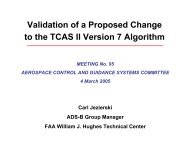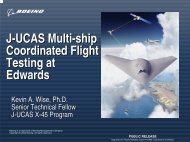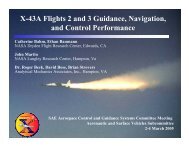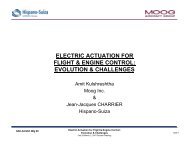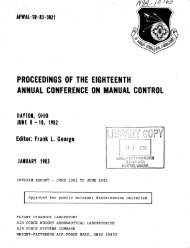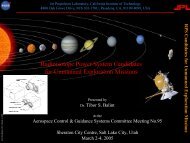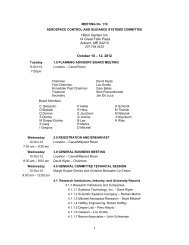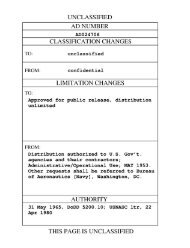Report of the Second Piloted Aircraft Flight Control System - Acgsc.org
Report of the Second Piloted Aircraft Flight Control System - Acgsc.org
Report of the Second Piloted Aircraft Flight Control System - Acgsc.org
You also want an ePaper? Increase the reach of your titles
YUMPU automatically turns print PDFs into web optimized ePapers that Google loves.
There has been some work done at. The F'ranklin Institute on <strong>the</strong><br />
problem <strong>of</strong> studying human frequency response with <strong>the</strong> view in mind <strong>of</strong><br />
obtaining "transfer functions ,It on a project sponsored by <strong>the</strong> United<br />
States Air ~orce.6,7,8 The method which this project has selected for<br />
studying <strong>the</strong> human operatorts frequency response is <strong>the</strong> comparison <strong>of</strong><br />
<strong>the</strong> output spectral density to <strong>the</strong> spectral density <strong>of</strong> <strong>the</strong> visual input<br />
using a random signal as <strong>the</strong> input. Such a comparison yields utleFul<br />
informetion whe<strong>the</strong>r or not <strong>the</strong> human operator behaves in a lineer<br />
fashion. Were a linear aystem under study, it can be ehom that <strong>the</strong><br />
amplitude part <strong>of</strong> <strong>the</strong> systemle frequency response is equal to <strong>the</strong> square<br />
root <strong>of</strong> <strong>the</strong> ratio <strong>of</strong> <strong>the</strong> speotral density <strong>of</strong> <strong>the</strong> output to <strong>the</strong> spectral<br />
density <strong>of</strong> <strong>the</strong> input. A complete description <strong>of</strong> <strong>the</strong> linear eyatem would<br />
reqnlre <strong>the</strong> cross spectral density <strong>of</strong> <strong>the</strong> output and input so that<br />
phase as well as amplitude characterietics could be specified. Since<br />
<strong>the</strong> computation <strong>of</strong> <strong>the</strong> cross spectral density would have required twlce<br />
as much work as <strong>the</strong> computation <strong>of</strong> spectral densities, it was decided<br />
that only <strong>the</strong> amplitude response would be computed in <strong>the</strong> preliminary<br />
experiments. The main purpoee <strong>of</strong> <strong>the</strong> preliminary experimente, <strong>the</strong><br />
apparatus for which was a simple compensatory position tracking device,<br />
was to determine whe<strong>the</strong>r <strong>the</strong> foregoing input-output analysis was a<br />
suitable method for analyzing <strong>the</strong> data <strong>of</strong> more ambitious experimente using<br />
a dynamic flight simulator for a high speed jet fighter built by The<br />
Franklin Institute Leboratories. The random input function was obtained<br />
by constraining a pip on an oscilloscope to take positions on a horizontal<br />
axis alternatively to <strong>the</strong> left and to <strong>the</strong> right <strong>of</strong> a vertical<br />
fiducial line so that <strong>the</strong> number <strong>of</strong> zero crossings were described by a<br />
Poisson distribution. In order to make <strong>the</strong> display somewhat less<br />
predictable <strong>the</strong> amplitudes to <strong>the</strong> left and to <strong>the</strong> right were rtandamly<br />
selected from a Gaussian population <strong>of</strong> <strong>the</strong> same mean and standard<br />
deviation for amplitudes to <strong>the</strong> left and to <strong>the</strong> right. One <strong>of</strong> <strong>the</strong> underlying<br />
reasons for selecting a random time series input was <strong>the</strong> belief<br />
that <strong>the</strong> human operator is largely non-linear. This particuhr random<br />
time series had a specitrum which was similar to <strong>the</strong> spectrum <strong>of</strong> atmoepheric<br />
turbulence.<br />
In order. to add psychological interkt to <strong>the</strong> investigation <strong>of</strong> <strong>the</strong><br />
applicability <strong>of</strong> <strong>the</strong> analytical procedures, three questions were examined.<br />
Does <strong>the</strong> operator track <strong>the</strong> random input in a linear fashion? How does<br />
his behavior change as a function <strong>of</strong> practice? How do different instructions<br />
affect his response patterns? The question <strong>of</strong> linearity was<br />
examined by comparing <strong>the</strong> amplitude frequency response for two subjects<br />
when tracking a distribution whose mean absolute amplitude was one<br />
centimeter and when tracking a distribution <strong>of</strong> mean absolute amplitude<br />
equal to two centimeters. The effect <strong>of</strong> practice, i.e., time variation<br />
<strong>of</strong> <strong>the</strong> system, was exambed by comparing <strong>the</strong> output <strong>of</strong> <strong>the</strong> two subjects<br />
when naive and when hi.ghly trained in following a certain random input<br />
signal. The effects <strong>of</strong> instructions to track for accuracy and <strong>of</strong><br />
instructions to track for speed were compared for two subjects in order



